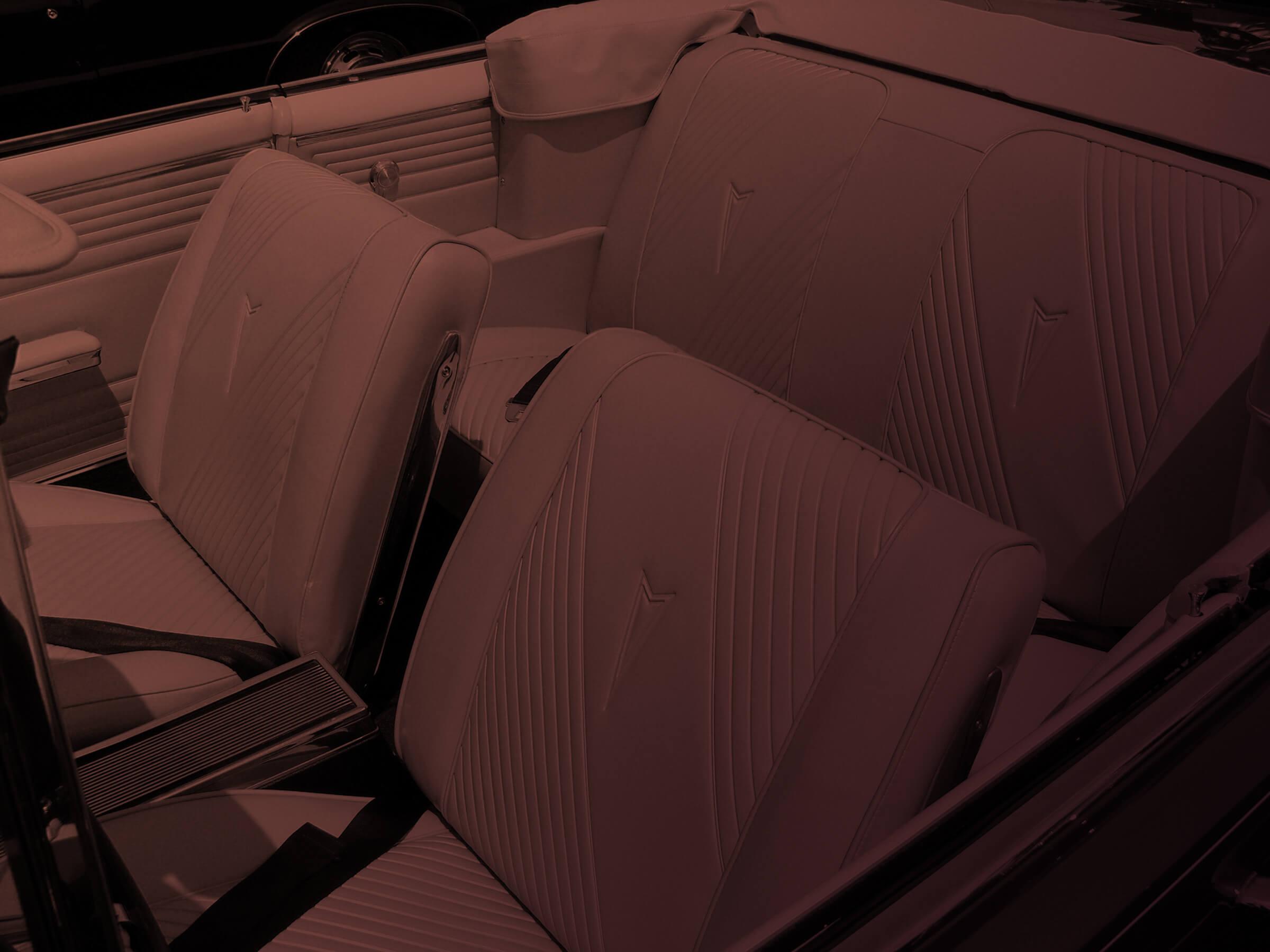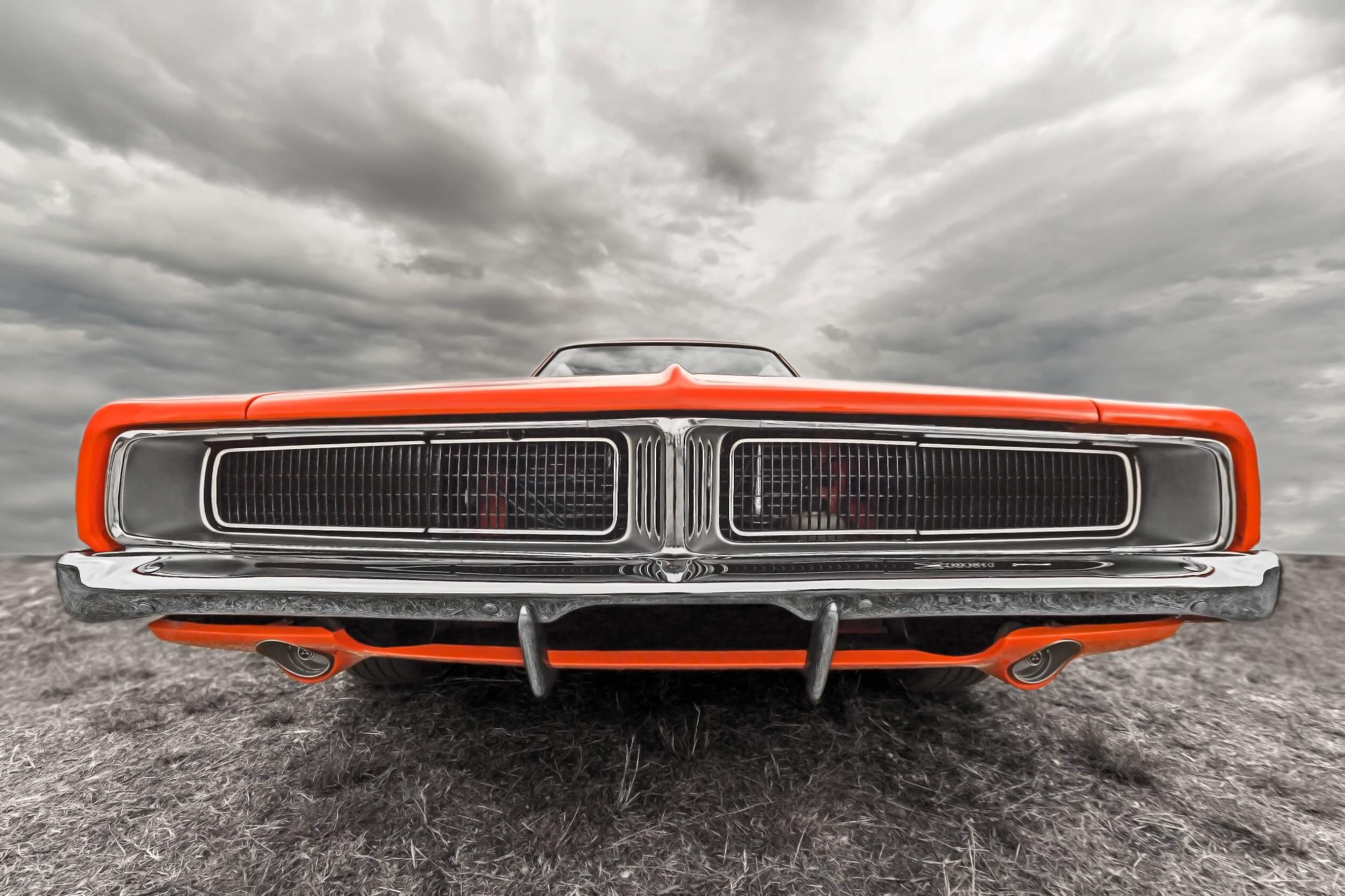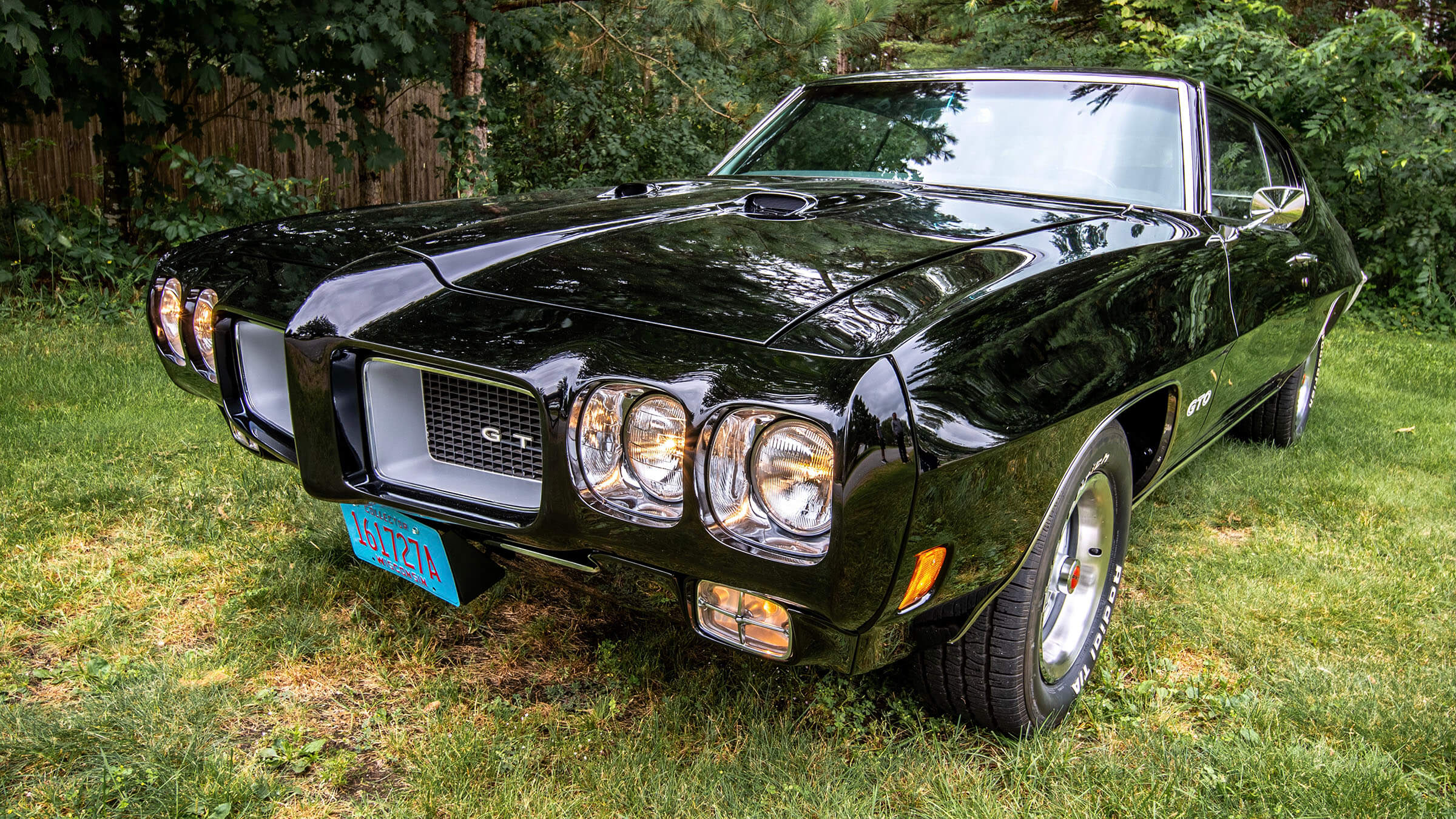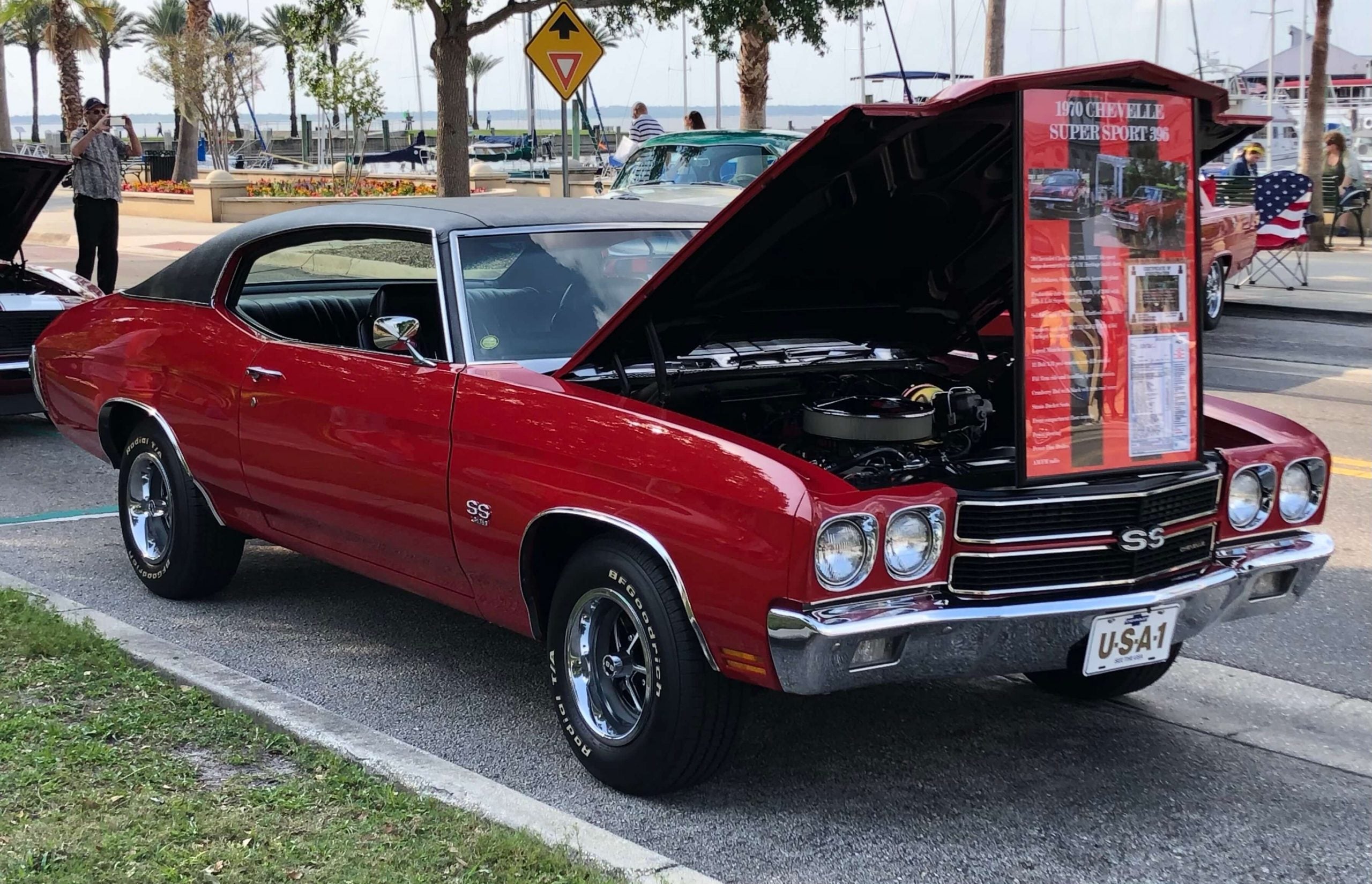Video Transcript
Hi, I’m Ron Halbritter, technical advisor for Legendary Auto Interiors and I’d like to welcome you to the Legendary Studio where today we’re going to show you the proper way to install a vinyl top on our 1970 Charger. You’ll be able to use this video as a guideline for installing any vinyl top on a 1968 through 1970 Charger. This particular top is a gator green top, which was factory original on this car, but first we have some preparation work to do before we start gluing the vinyl top on.
You’re going to get your car back nine times out of ten from the body shop with the paint and clear coat up on top of the roof. We’ve got to sand this so the vinyl top adhesive bites to the actual car and adheres to the vinyl top.
Together with Legendary Auto Interiors and John J Barosky, we’re going to show you why Legendary Auto Interiors is number one with collectors, restorers, and enthusiasts worldwide.
Our first step will be to scuff or sand the whole top of the car where the vinyl top is going to be glued. We normally sand that with a 220 sandpaper–that will sand through the clear to get that glue to bite. Every place that the vinyl top is glued needs to be sanded or else it’s going to create air bubbles underneath.
It’s a good idea that after you sand the car, blow the remaining clear or any extra paint off it. We normally spray it down with a wax and grease remover after this. This will actually take any of the clear powder remaining off of it, so when you glue the top on there it will stick.
Our next step will be to find the center point of the car itself. You want to measure inside where the windshield sets in if the glass is in the car. Just measure across the front, then repeat the process on the back side, measuring from drip rail edge to drip rail edge.
We want to spray some vinyl top adhesive in about a four-inch section along the center portion of the car and the center portion of the vinyl top. This is the first section that needs to be glued to the car. You want to apply a generous amount to both the vinyl top and the car roof. The vinyl top adhesive acts like a contact cement and needs to be applied to both. You want to let it get good and tacky, then you must stretch the vinyl top, press it down, and glue the vinyl top to the roof of the car.
Our next step will be to glue one side of the car from the seam all the way to the center where we’ve previously glued. Again, you want to spray vinyl top adhesive to the vinyl side and the steel side of the roof. This is a very important step where you want to A) pull the wrinkles out, and B) keep that seam straight along the entire length of the car. It’s a good idea to start at the back edge, pull the wrinkles out, and when you get to the front edge you can have another person look down that seam and make sure that seam is straight going front to back on the car. It’s a good idea to let the adhesive get good and dry just in case you want to lift that back up and straighten out your line a little bit your seam that runs front to back. You want to make sure that’s perfectly straight, and if the glue is a little bit dry you can lift it back up and replace it or reposition it where you need to.
Essentially, what we’re doing is doing the entire center deck first. Occasionally you might have an a wrinkle that needs to be lifted and pulled and stretched out and glued down or just pressed down, but as soon as you rub that adhesive or rub the vinyl top it’s pretty much going to be set in place, so it’s a good idea to put the vinyl top on with the glue as dry as possible when it’s a little more forgiving.
Your last step is to go through and rub the vinyl top all the way down along the seams and along that center deck. you don’t want to see any air bubbles–you want to check down the seam making sure that’s straight. A good second pair of eyes in this situation helps out greatly.
Our next step will be to repeat the process on the opposite side. We again want to glue the roof of the car and the vinyl and let it tack up good. We want to stretch the vinyl out just enough to get any wrinkles out. Press down the seam, making sure you keep that seam straight front to back, and this should finish off glueing the center deck to the roof of the car.
For our next step we want to glue the top and the car from the seams all the way to the outside. You want to start in the rear quarter section after the glue gets good and tacky, or almost dry. We want to gently work any wrinkles and pull some tension on that vinyl as you’re working it down along the rear window and along the quarter panel.
Normally, on most vinyl tops the section below the rear window needs to be glued (if it has a rear valence below the rear window) before we move to our outside edges where we are right now, but the Charger does not have that section so we’re moving right along to the outside edges of the car.
Once we get the rear section all glued down along the rear edge of the window we can actually move forward and do the quarter panel area. You can stretch out any wrinkles and just start rubbing it down and getting any wrinkles out. This is a very, very important step because it tends to get a lot of wrinkles in this area. This is the reason why you have to follow these steps so you don’t get any wrinkles when you’re installing this vinyl top.
The vinyl top needs to be worked down all the way to the drip rail edge. You want to tuck that vinyl top down in and just keep in mind how when you glue in the areas down how it relates to the other sections of vinyl and how it’s going to look. You’ll see John actually has a plastic tuck tool, where he’s smoothing out any of the wrinkles and actually tucking that vinyl down inside the drip rail edge because the vinyl top actually has to come down and follow the curve of the drip rail edge to where the drip rail edge curves up and then is trimmed off flush with the top edge of the drip rail. It does not overhang the edge of the drip rail, which we’ll show you later.
Inside the drip rail edge you want to take a tool that’s not going to cut the vinyl top (John has a rounded plastic tool) and work that vinyl down inside the drip rail edge and inside the edges where the windshield sets in. You want to carefully work the material over the edge, making sure there’s no wrinkles. Eventually, this excess will be trimmed off but it’s nice to have it just in case you need to lift the edges up and reposition your vinyl top. You want to trim off any excess, but leave yourself plenty before you make your final trimming.
You want to repeat the process along the back window as well, tucking the vinyl over the edge where the glass lays into the car. This is where your windshield and rear window molding clip attaches. You see that John has a tuck tool and is working that vinyl over the edge, making sure there’s no bubbles under the vinyl top.
Then, we’re trimming off any excess. You want to make sure that that vinyl gets trimmed right along the very top edge. We don’t do our final trimming at this point, we just cut off a lot of the major excess. We can actually go along and do our final trimming just before we’re finished up. We’re just trying to get some of the excess material, as these vinyl tops are made to have a lot of excess material, so it gives you a little more freedom when you’re installing the vinyl top and it gives you something to grab a hold of to pull the wrinkles out.
Now we want to repeat the process on the opposite side, gluing our vinyl top, gluing the top of the car and repeating the process on the opposite side as well. It should go a little bit easier on this last section because you’ve already practiced on the other side. Again, we want to start at the rear quarter section and kind of get a feel of how it’s gonna look along that rear top edge of the rear quarter and along the fin that meets the trunk. Then we want to work our way down to the quarter panel area and then work our way to the front pillar very last. This is a very important step and you get a lot of wrinkles in this area if you’re not careful and you’re not thinking ahead as you’re pulling the vinyl down towards the outside of the car.
You want to carefully make sure that you’re going a couple inches at a time. You want to make sure that glue is good and dry just in case you have to lift that section back up and reposition it. For the quarter panel area, you want to pull down and towards the rear section of the car so that way it gives you a little more freedom as you’re working your way up towards the front edge of the car and the A-pillar.
Now you can get an idea of how the vinyl top is going to look. You will want to make some relief cuts at your points where the vinyl top bends and goes down the A-pillar. That way you don’t have any buckles and it’s a little bit easier to work the vinyl over and down in the drip rail edge area. You want to be very cautious of how that vinyl folds around that drip rail edge, as well. You don’t want to glue it and not tuck it down there deep, because a lot of times when you trim it and then you find out that you haven’t glued it all the way down along the bottom edge of that drip rail you wind up showing some steel after you put the molding edges on the car, or the vinyl top will want to shrink up a little bit and it actually pulls away from that drip rail edge. So you want to leave yourself plenty of extra material before we do our final trimming.
Then we want to do the inside edge of the fin area back near the rear window. We Want to make some relief cuts so that vinyl bends a little easier. Then you want to again take that plastic tuck tool and press that vinyl down inside the area where the windshield sets into the automobile.
You then trim off any excess again, and this is not where you make your final trimming. We’re just trimming off a lot of the excess right now and then we can go back and make our final trimming after we dry fit our chrome moldings. You’ll see we’re cutting with a pair of scissors, but you can actually do the same thing with a sharp razor blade. When you get to the seams, there’s a lot of material there so when you go to cut that you want to make sure that you’re very careful where you’re cutting because it’s a little difficult to cut.
In our next step, we can actually go back and make our final trimming. You see John has a tuck tool or something that’s going to prevent that razor blade edge from cutting into the vinyl top that’s installed onto the car. It’s just a nice safety precaution. It’d be a shame to get this far and then have a a slice in your vinyl top and be back at square one again.
If there are any emblems that go in the corner area like this Charger emblem, you’ll see the emblem actually has posts on it that pokes through the vinyl top, through the body of the car, and has acorn nuts on the back side that are screwed on.
Our next step will be to mount the chrome trim that actually goes on the front edge of the vinyl top in the quarter panel area. After your emblem is on, you want to tuck the curved portion where the drip rail meets the body of the car. Be careful not to scratch the car when you’re putting the stainless back on–it’s really easy to do. The stainless piece actually screws and mounts to the car from the inside of the car out. You want to tuck that chrome piece back as far as you possibly can. The chrome rests on top of the body and then there are four screws that hold that chrome trim to the body of the car itself.
For our next step, we want to mount the drip rail edge chrome. It snaps over the top of the drip rail edge on the top edge and then clips down on the lower edge, so you kind of rest it over the top and then snap it down on the bottom side. You can actually do it with the heel of your hand very quickly. Then you want to come up to the front A-pillar and the stainless trim mounts the exact same way. Then we want to repeat the process on the opposite side as well.
In our next step, we want to install the stainless trim on the back quarter edges. You’ll see it has posts on it and they actually have acorn nuts on the back side of it that tighten it down to the body of the car. On the front sides–and all the holes where any stainless goes through–you want to make sure there’s some 3M gasket material behind this so no water gets behind it. Then you want to snap the stainless trim with the clips through those holes and make a tight seal.
Now you want to dry fit everything before you actually snap it into place, because when you snap it into place you want that to be your final installation.
Hopefully this video has been very helpful for you. You can see actually how easy–or hard–it is to do a vinyl top. Now keep in mind if you’re doing a vinyl top on any other model car that has a rear valence below the rear window, you want to do that center deck first, then come back and do that panel located just below the rear window, and then do the outsides of the car very last.




